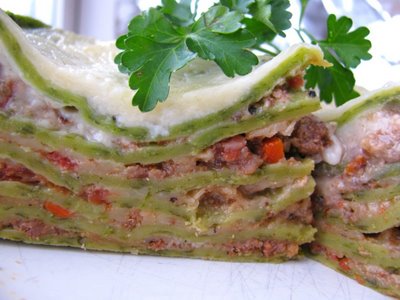
The March 2009 challenge is hosted by Mary of Beans and Caviar, Melinda of Melbourne Larder and Enza of Io Da Grande. They have chosen Lasagne of Emilia-Romagna from The Splendid Table by Lynne Rossetto Kasper as the challenge.
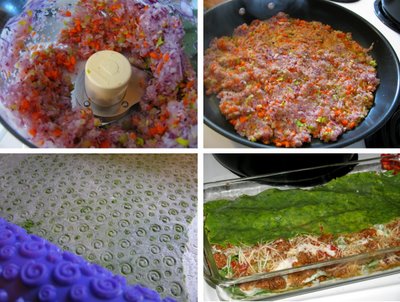
This months’ Daring Baker’s Challenge was definitely work. It took several hours to make but fortunately I had Eric and my sister Sharon to help me. It was lots of fun to see the different things they came up with. Like in the pictures above, Sharon used her fondant roller on a piece of dough to see if it would make a design, it looked really cool though of course it didn’t show once the lasagna was put together. In the picture below, Eric had the cool idea of forming the flour around a measuring cup to make a bowl to mix the egg and spinach in. We all had a lot of fun working together, and they had fun photographing me whenever I set the camera down to work!

By the way, if you wear a wedding ring, or any ring, you’ll want to remember to take them off before kneading the dough. Your hands get very green and messy in the process!

Although none of the components were necessarily difficult in themselves, there are a lot of steps so you really need a good chunk of time and a lot of kitchen space. My parents’ kitchen was perfectly clean when we got started, and look how messy it got.
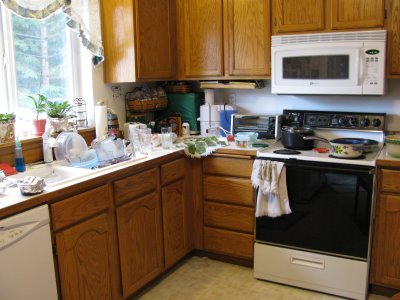
But it was worth. The lasagna is really beautiful, even as you’re making it. The noodles are so good for you with all the spinach, and the meat sauce has plenty of veggies too. When Eric brought leftovers to work, his co-workers freaked out because they thought he was microwaving lettuce. They were amazed that it was lasagna. The real test was my brother Jason who, as I said before, is autistic and so very picky. He was not excited about green noodles and said he’d rather go get a box of frozen lasagna and cook that. I offered to freeze my lasagna for him and let him reheat it 🙂 He thought that was funny. But once he tried it, he really liked it, and was excited it contained at least a serving of vegetables.

I don’t know if I’d make the whole recipe again, but I definitely love the pasta recipe and want to use it for ravioli someday.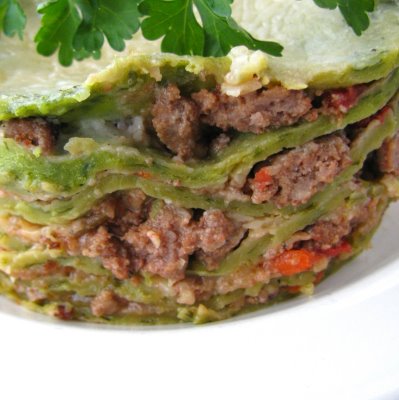
Serves 8 to 10 as a first course, 6 to 8 as a main dish

Spinach Egg Pasta (Pasta Verde)
Makes enough for 6 to 8 first course servings or 4 to 6 main course servings, equivalent to 1 pound dried boxed pasta.
2 jumbo eggs or 3 regualar
Equipment:A roomy work surface, 24 to 30 inches deep by 30 to 36 inches. Any smooth surface will do, but marble cools dough slightly, making it less flexible than desired. A pastry scraper and a small wooden spoon for blending the dough. A wooden dowel-style rolling pin. In Italy, pasta makers use one about 35 inches long and 2 inches thick. The shorter American-style pin with handles at either end can be used, but the longer it is, the easier it is to roll the pasta. Plastic wrap to wrap the resting dough and to cover rolled-out pasta waiting to be filled. It protects the pasta from drying out too quickly. A sharp chef’s knife (or pizza wheel) for cutting pasta sheets.Cloth-covered chair backs, broom handles, or specially designed pasta racks found in cookware shops for draping the pasta.
Mixing the dough:Mound the flour in the center of your work surface and make a well in the middle. Add the eggs and spinach. Use a wooden spoon to beat together the eggs and spinach. Then gradually start incorporating shallow scrapings of flour from the sides of the well into the liquid. As you work more and more flour into the liquid, the well’s sides may collapse. Use a pastry scraper to keep the liquids from running off and to incorporate the last bits of flour into the dough. Don’t worry if it looks like a hopelessly rough and messy lump.
Kneading:With the aid of the scraper to scoop up unruly pieces, start kneading the dough. Once it becomes a cohesive mass, use the scraper to remove any bits of hard flour on the work surface – these will make the dough lumpy. Knead the dough for about 3 minutes. Its consistency should be elastic and a little sticky. If it is too sticky to move easily, knead in a few more tablespoons of flour. Continue kneading about 10 minutes, or until the dough has become satiny, smooth, and very elastic. It will feel alive under your hands. Do not shortcut this step. Wrap the dough in plastic wrap, and let it relax at room temperature 30 minutes to 3 hours.
Stretching and Thinning:If using an extra-long rolling pin work with half the dough at a time. With a regular-length rolling pin, roll out a quarter of the dough at a time and keep the rest of the dough wrapped. Lightly sprinkle a large work surface with flour. The idea is to stretch the dough rather than press down and push it. Shape it into a ball and begin rolling out to form a circle, frequently turning the disc of dough a quarter turn. As it thins outs, start rolling the disc back on the pin a quarter of the way toward the center and stretching it gently sideways by running the palms of your hands over the rolled-up dough from the center of the pin outward. Unroll, turn the disc a quarter turn, and repeat. Do twice more.
Stretch and even out the center of the disc by rolling the dough a quarter of the way back on the pin. Then gently push the rolling pin away from you with one hand while holding the sheet in place on the work surface with the other hand. Repeat three more times, turning the dough a quarter turn each time.
Repeat the two processes as the disc becomes larger and thinner. The goal is a sheet of even thickness. For lasagne, the sheet should be so thin that you can clearly see your hand through it and see colours. Cut into rectangles about 4 by 8 inches (10 x 20 cm). Note: Enza says that transparency is a crucial element of lasagne pasta and the dough should be rolled as thinly as possible. She says this is why her housekeeper has such strong arms!
Dry the pasta at room temperature and store in a sealed container or bag.
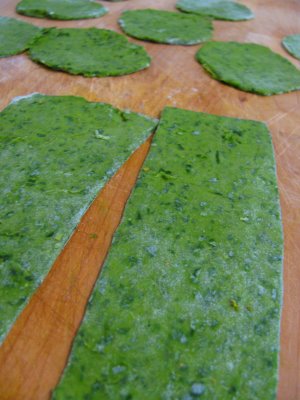
Bechamel
Preparation Time: 15 minutes
Ingredients
4 tablespoons unsalted butter
4 tablespoons all purpose unbleached (plain) flour
2 & 2/3 cups milk
Salt and freshly ground pepper to taste
Freshly grated nutmeg to taste
Instructions
Using a medium-sized saucepan, melt the butter over low to medium heat. Sift over the flour, whisk until smooth, and then stir (without stopping) for about 3 minutes. Whisk in the milk a little at a time and keep the mixture smooth. Bring to a slow simmer, and stir 3 to 4 minutes, or until the sauce thickens. Cook, stirring, for about 5 minutes, until the sauce thickens. Season with salt, pepper, and a hint of nutmeg.
Country Style Ragu’ (Ragu alla Contadina)
Makes enough sauce for 1 recipe fresh pasta or 1 pound dried pasta
Ingredients
3 tablespoons extra virgin olive oil
2 ounces pancetta, finely chopped
1 medium onion, minced
1 medium stalk celery with leaves, minced
1 small carrot, minced
4 ounces boneless veal shoulder or round
4 ounces mild Italian sausage (made without fennel)
8 ounces beef skirt steak, hanging tender, or boneless chuck blade or chuck center cut (in order of preference)
1 ounce thinly sliced Prosciutto di Parma
2/3 cup dry red wine
1 &1/2 cups chicken stock (homemade if possible)
2 cups milk
5 canned plum tomatoes, drained
Salt and freshly ground black pepper to taste
Instructions
Working Ahead:The ragu can be made 3 days ahead. Cover and refrigerate. It also freezes well for up to 1 month. Skim the fat from the ragu’ before using it.
Browning the Ragu Base:Heat the olive oil in a 12 inch (30cm) skillet (frying pan) over medium-high heat. Have a large saucepan handy to use once browning is complete. Add the pancetta and minced vegetables and sauté, stirring frequently with a wooden spoon, 10 minutes, or until the onions barely begin to color. Coarsely grind all the meats together, including the prosciutto, in a food processor or meat grinder. Stir into the pan and slowly brown over medium heat. First the meats will give off a liquid and turn dull grey but, as the liquid evaporates, browning will begin. Stir often, scooping under the meats with the wooden spatula. Protect the brown glaze forming on the bottom of the pan by turning the heat down. Cook 15 minutes, or until the meats are a deep brown. Turn the contents of the skillet into a strainer and shake out the fat. Turn them into the saucepan and set over medium heat.
Reducing and Simmering:Add the wine to the skillet, lowering the heat so the sauce bubbles quietly. Stir occasionally until the wine has reduced by half, about 3 minutes. Scrape up the brown glaze as the wine bubbles. Then pour the reduced wine into the saucepan and set the skillet aside.Stir ½ cup stock into the saucepan and let it bubble slowly, 10 minutes, or until totally evaporated. Repeat with another ½ cup stock. Stir in the last 1/2 cup stock along with the milk. Adjust heat so the liquid bubbles very slowly. Partially cover the pot, and cook 1 hour. Stir frequently to check for sticking.Add the tomatoes, crushing them as they go into the pot. Cook uncovered, at a very slow bubble for another 45 minutes, or until the sauce resembles a thick, meaty stew. Season with salt and pepper.

Mmm, your lasagne looks amazing!! I love your photos =D!!
Hello,
We bumped into your blog and we really liked it – great recipes YUM!!! YUM!!!.
We would like to add it to the Petitchef.com.
We would be delighted if you could add your blog to Petitchef so that our users can, as us,
enjoy your recipes.
Petitchef is a french based Cooking recipes Portal. Several hundred Blogs are already members
and benefit from their exposure on Petitchef.com.
To add your site to the Petitchef family you can use http://en.petitchef.com/?obj=front&action=site_ajout_form or just go to Petitchef.com and click on "Add your site"
Best regards,
Vincent
petitchef.com
diana,
hey! i think you were early on your post. it’s the 29th, i think…nevertheless, nice job on your lasagne.